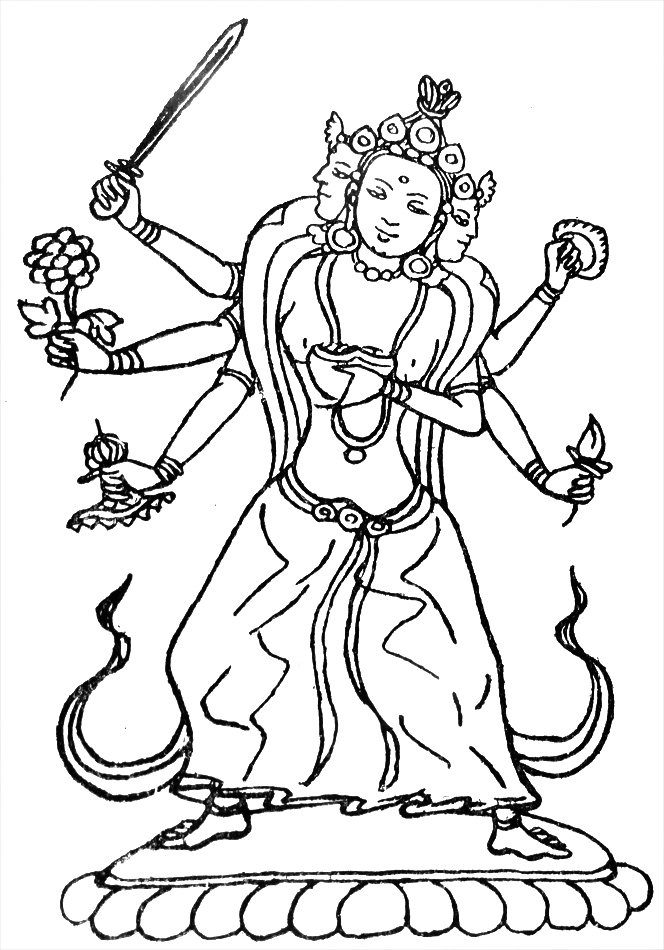The Indian Buddhist Iconography
by Benoytosh Bhattachacharyya | 1958 | 51,392 words | ISBN-10: 8173053138 | ISBN-13: 9788173053139
This page contains an iconography image of Hindu Gods: Vajrasarasvati and represents figure 235 of the book Indian Buddhist Iconography, based on extracts of the Sadhanamala English translation. These plates and illustrations represent either photographs of sculptures or line-drawing reproductions of paintings or other representations of Buddhist artwork.
Figure 235 - Hindu Gods: Vajrasarasvatī

Fig. 235: Vajrasarasvatī
It is not a fact that Hindu gods [viz., Vajrasarasvatī] were unknown in the Buddhist pantheon or that the Buddhist pantheon wholly consisted of Buddhist gods. [...] A perusal of the Niṣpannayogāvalī and especially the Dharmadhātuvāgīśvara-maṇḍala will show what a large number of Hindu deities was incorporated in the Mandala, and how this large number was tackled intelligently and fitted into the scheme of the Buddhist Maṇḍalas. [...] Amongst the Hindu deities incorporated into the Buddhist pantheon, three deities appear to be of great importance. These are Mahākāla the prototype of Śiva Mahādeva with the Triśūla as the recognition symbol, Gaṇapati the elephant-faced god, and Sarasvatī the Goddess of Learning with her characteristic Vīṇā. Separate Sādhanas are assigned to all of them, and even independent shrines for them are not wanting in the Buddhist countries of the North.
Sarasvatī is the name of an ancient river now filled up by the sands of Rajputana on the banks of which the Vedic Aryans originally settled after their migration to India. As the banks of the river were occupied by the Vedic Aryans who composed many hymns, and were the scene of many sacrifices, the river was, later on, in the Pauranic age deified as the the Goddess of Learning. The Buddhists borrowed this Hindu goddess, incorporated her bodily into their pantheon in the Tantric age when she was equally popular with the Hindus and the Buddhists, and modified her form in various ways. The Buddhist Sarasvatī may have one face with two arms, or three faces and six arms. When two-armed, she has four different variations. As her worship is widely prevalent among the Buddhists owing to the belief that like Mañjusrī and Prajñāpāramitā, she confers wisdom, learning, intelligence, memory, etc. a comparatively large number of Sādhanas is assigned to her in the Sādhanamālā.
Vajrasarasvatī:
Faces: three;
Arms: six;
Āsana: pratyālīḍha.
The name Vajrasarasvatī is given to this goddess in order to distinguish her from the other four varieties of Sarasvatī, with four different names given in the Sādhanas. It has already been said that Sarasvatī has a form with three faces and six arms. In all other respects her form is identical with that of Mahāsarasvatī. The difference here is that her hair is brown and rises upwards, and she stands in the Pratyālīḍha attitude on the red lotus. Three Sādhanas in the Sādhanamālā are assigned to her worship, and according to these, she is red in colour, with the right and left faces of blue and white colour respectively. She carries in her three right hands the lotus on which is the Prajñāpāramitā Book, the sword and the Kartri, and in the three left the Kapāla of Brahmā, the jewel and the Cakra. Instead of the book on lotus and Brahmakapāla she may also hold the lotus and the Kapāla only.
Fig 235 illustrates a Nepalese drawing belonging to the latter variety.
